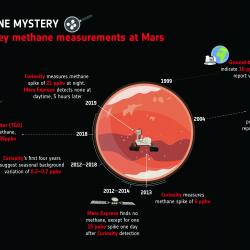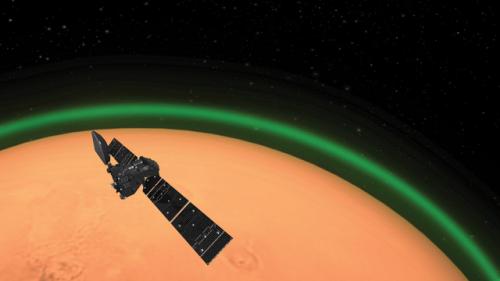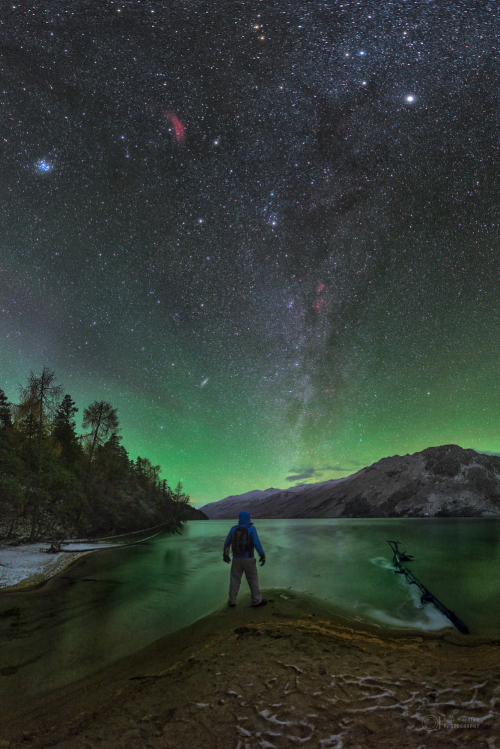The NOMAD instrument, developed at the Royal Belgian Institute for Space Aeronomy and currently in orbit around Mars on board ESA's ExoMars Trace Gas Orbiter, has detected a unique green glow of oxygen in the atmosphere surrounding the red planet (around 80 km altitude). This emission gives its characteristic colour to the terrestrial polar aurora and airglow, but was never observed before in other planetary atmospheres outside of the Earth. This light emission is created by the interaction between solar radiation and carbon dioxide, which is the major constituent of the Mars atmosphere. At Mars, as a big natural laboratory, we also succeeded to measure the two oxygen lines in the visible and ultraviolet ranges simultaneously, which clarifies a long-standing controversy between discordant quantum mechanics calculations and atmospheric measurements on Earth.
DOI: 10.1038/s41550-020-1123-2
Glowing of the atmosphere
On Earth, glowing oxygen is produced during polar auroras when energetic electrons from the Sun hit the upper atmosphere. This oxygen-driven emission of light gives polar auroras their beautiful and characteristic green hue. The aurora, however, is just one way in which planetary atmospheres light up.
The atmospheres of planets including Earth and Mars glow constantly during both day and night as sunlight interacts with atoms and molecules within the atmosphere, a phenomenon commonly called “airglow”.
Discovery of the green light at Mars
Even though green dayglow has been predicted to exist at Mars for around 40 years, until now, it had never been observed in the atmospheres of other planets, either because their surface is too bright relative to the atmospheric light emission or because earlier missions to the planets were not equipped with instruments sensitive to both visible and ultraviolet light. To remedy this, the NOMAD team at the Royal Belgian Institute for Space Aeronomy and the Université de Liège decided to reorient the instrument’s Ultraviolet and Visible (UVIS) channel from its typical nadir orientation (looking directly down at the Martian surface) to point at the dayside limb (the ‘edge’ of Mars).
Between 24 April and 1 December 2019, the NOMAD team used UVIS to scan altitudes ranging from 20 to 400 kilometres from the Martian surface twice per orbit. On every one of those ‘special limb observation modes’, the instrument detected strikingly bright signals at 557.7 nanometers (Figure 2 right), demonstrating the omnipresence of the green dayglow. The main peak altitude was located near 80 km, and its intensity varied as a result of the changing distance between Mars and the Sun, the local time and latitude of the observations. A second emission peak was observed near 120 km (Figure 2 left).
Mars as a natural laboratory
Another weaker emission of the oxygen dayglow was also observed at 297.2 nanometer in the near ultraviolet range (Figure 2 right). Such a simultaneous measurement of two oxygen lines in the visible and ultraviolet spectral range is quite unique. It allowed to directly derive a ratio of 16.5 between the visible and the UV emissions, which is difficult even in the laboratory on the Earth.

A photochemical model, developed at the Université de Liège, was used to better understand this green glow at Mars, and to compare it to what we see around our own planet. The model was able to reproduce the altitude and the brightness of the airglow layer. It additionally indicated that the green dayglow on Mars is mostly produced when the major gas in the red planet’s atmosphere, carbon dioxide molecules (CO2), is broken up into its constituent parts: oxygen (O) and carbon monoxide (CO) by the incoming far ultraviolet sunlight. The resulting oxygen atoms were glowing in both visible and ultraviolet light.
Our result agrees with models of atomic physics but contradicts earlier observations made in the Earth’s airglow and aurora. The emission ratio of 16.5, found in this study, will be considered as a standard for measurements connecting the ultraviolet to the visible spectral regions. This result has consequences for the study of auroral and airglow processes and for spectral calibration of optical instruments.
Contact
- Shohei Aoki, co-author of the Nature Astronomy article - Shohei (dot) Aoki (at) aeronomie (dot) be
- Karolien Lefever, Head of Communication – Karolien (dot) Lefever (at) aeronomie (dot) be, +32 471 66 53 50
More information
- These observations are reported in a letter entitled “Detection of green line emission in the dayside atmosphere of Mars from NOMAD-TGO observations”, by J.-C. Gérard et al., published on June 15 in Nature Astronomy.




